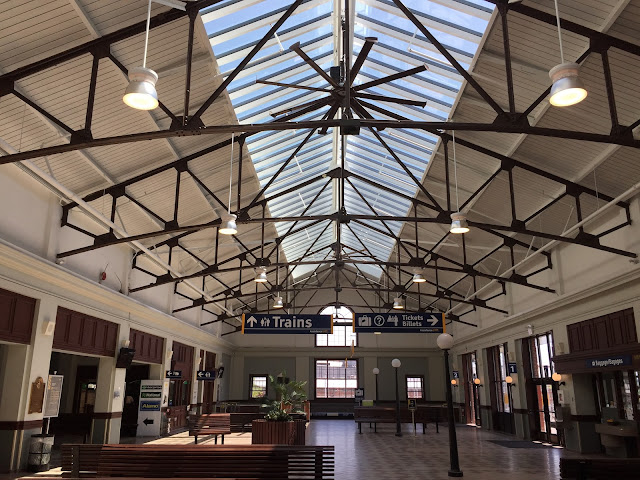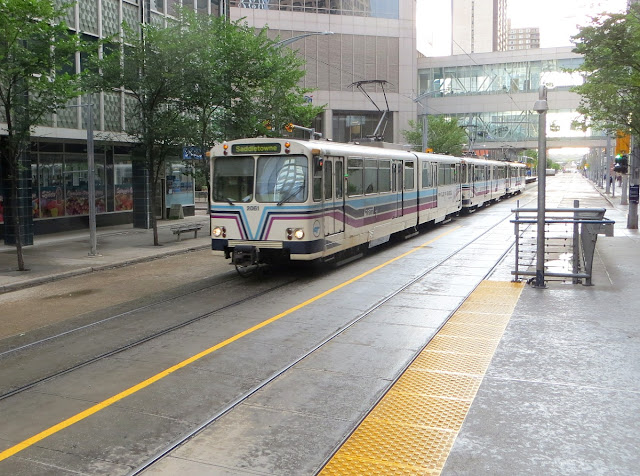The new slogan is showing up all over VIA materials and properties, and has even made its way to the trains themselves. As the 40th anniversary branding starts to disappear, wrapped locomotives that first bore Canada 150 branding have now migrated to a new look, with the bilingual slogans joining the large VIA logos atop silver sides. On August 2, I had the chance to catch locomotive 6416 on its first journey to the Maritimes in the new livery, leading Train 15 as it departed Halifax.
 |
| Rounding the bend towards the Young Ave overpass, next to lines of container cars and under the extensive grain loading infrastructure. |
 |
| "la voie qu'on aime" - turn over locomotive for English instructions. |
As usual this summer, the Ocean has swelled to accommodate many summer time travellers. One set of equipment is the usual enormous Renaissance consist, with 5 coaches, 9 sleepers, and a crew Chateau sleeper ahead of the Park car. The other set of equipment, seen in the photos above and below, is something quite new - a mixed set of HEP and Renaissance equipment, with HEP baggage and four coaches, followed be a Renaissance block of transition, accessible coach, service car, diner, service car, accessible sleeper, sleeper, and transition, and finally another HEP block of 6 Chateau sleepers and the Park car; a monster of a train, necessitated by damage to Ren equipment over the winter and a shortage of HEP diners. It does have the benefit of maintaining consistent dining service between the two trains (particularly helpful for the crew), offering accessible Renaissance coach and sleeper space, and also offering up a variety of HEP accommodations for folks who prefer that option. This consist is slated to stay on until after Christmas, according to the VIA reservation system, and it seems entirely possible that it could remain beyond that. Will we ever see a return to two full Ren sets?
 |
| HEP coaches, with alternating CP and American ancestry, make up the first part of the train. |
 |
| The Renaissance block begins - transition cars are required at both ends to make this work. |
 |
| The coach block - some passengers are seated in the Renaissance coach rather than the HEP coaches ahead. |
 |
| The full Ren block, with second transition before the Chateau sleepers. |
 |
| Rens snaking through the crossovers, their diminutive size on display between the two HEP blocks. |
 |
| Tail end. |
Speaking of Halifax, the downtown VIA station has been undergoing major renovations over the last year. The roof and skylight needed to be replaced, and this work meant that for the past year, the interior of the station has been taken up with scaffolding (tastefully hidden behind temporary walls) and a low drop ceiling, which restricted space in the station and made for tight quarters at busy times, especially for claiming baggage. Thankfully this work has come to an end, and the results appear to be well worthwhile. Have a look at the before and after:
 |
| Then - Halifax station mid-renovations, with scaffolding and drop ceiling. |
 |
| Now - opened back up, with new roof and skylights - beautiful! |
This summer has been filled with a good share of travelling on my end, but very little by train. In July I was off to Calgary, and despite some considerable time spent contemplating circuitous and convoluted rail routings that could get me part of the way there, it became clear that the 5h flight was the only really sensible option. Despite that, there were opportunities to work in some little bits of rail travel while in town.
The CTrain system is Calgary's light rail transit system, with two main lines (blue and red) that traverse between the northwest and southeast, and west and northeast, with the two sharing track through the downtown core. Apart from the downtown it's all off-street running, with a combination of grade separation at level, tracks in medians, elevated sections, tunnels, and even a good share of gated level crossings. Trains run on overhead electrification, and feature several generations of Siemens-built equipment with various interior arrangements. Trains feature twin cars that can be coupled together to make longer trains. The system is incredibly well used, and is a super effective way to quickly get around much of the city. I covered a good chunk of it while in town, and was happy to have managed to ride every generation of equipment.
 |
| A Series 8 Siemens SD-160NG train. |
 |
| The newest trains in the fleet - Siemens S200, delivered from 2013 onwards. By far the quietest trains inside, but less comfortable seating. |
 |
| Despite the less comfortable seats, the forward view from the S200 trains is the best in the fleet. |
Calgary boasts lots of freight action, but no intercity passenger rail. The Rocky Mountaineer does serve there, but its land-cruise setup (and high price tag) keep it from being any sort of useful transportation for most people. I would have been happy to see the train while in town, but didn't get the chance. Riding it was far out of the budget.
The one other bit of train riding I did fit in, however, came in the form of two different historic sites. The first was at Calgary's Heritage Park, an absolute must-visit attraction for anyone even remotely interested in the history of the region. The park is a living history museum with exhibits covering a wide-swath of Calgary's history, and it features some working exhibits not seen at many attractions of its kind - this includes a theme park with rides dating back to the early 20th century, a scaled down paddle-wheeler offering tours around the bay, and most excitingly, a full-size train running a loop around the park, with stops at three stations! It's an amazing thing to hear and see the steam locomotive making its way around the park. Rides are included with admission, so just hop on at any station and hop off wherever you please.
As if the steam train in the park weren't enough, there's also an old electric trolly that runs through the parking lot - for a modest fee, you can get a ride back to your car (or in our case, a slight detour en route to the bus stop).
 |
| On board the trolley. Just as good of a forward view as the new CTrains! |
Finally, our travels around near town brought us to the Atlas Coal Mine National Historic Site, which is near Drumheller AB. An easy drive from Calgary, it is well worth checking out. The history of coal mining in the region is fascinating, and the opportunity to tour the remnant of the mine and see the last standing wooden coal tipple in Canada is very much worthwhile. Plus, you can ride the little battery-powered mine train on a 2'-gauge railway around the site; but be forewarned, it's a rough ride!
Travelling along the CP route through the Rockies provided lots and lots of opportunities to see and appreciate railroading through the mountains. Unfortunately there is no passenger service on that line except for the Rocky Mountaineer, since VIA's Canadian was rerouted decades ago. It's a shame, because the spectacles of that route would be absolutely breathtaking from the rails. All the same, it was wonderful to appreciate the endless parade of freight trains, from vantage points high and low.
 |
| Dwarfed by the mountains - viewed from Paget Peak, both railway and highway through the Kicking Horse Pass look like tiny specks on the landscape. |
 |
| Viewed from Paget Peak, a CP grain train works its way up grade. From this point we could see two passing sidings and the length of mainline between them, with entire trains visible in a single view. |
So much of this country was built on the railways, and virtually all goods we use day to day still travel on ribbons of steel. It's sad that passengers can no longer ride on so many of the rail lines that still link those communities; yet it's wonderful that we have what we do, and always worth every opportunity to enjoy it - whether its the timeless beauty of VIA's stainless steel streamliners (the voyage which launched this blog), the preserved pieces of railway heritage, or the modern light rail systems that drive business in a bustling modern metropolis.
Love the way!
 |
| A closing view at Heritage Park. The scenes seemingly invite the photographer to play around with black and white and vintage looks. |





This post covered a lot of ground, both literally and figuratively, Tim! Thanks for sharing your travels! I'm just getting caught up on your passenger peregrinations now.
ReplyDeleteEric
Thanks for coming along for the (figurative) ride, Eric!
Delete